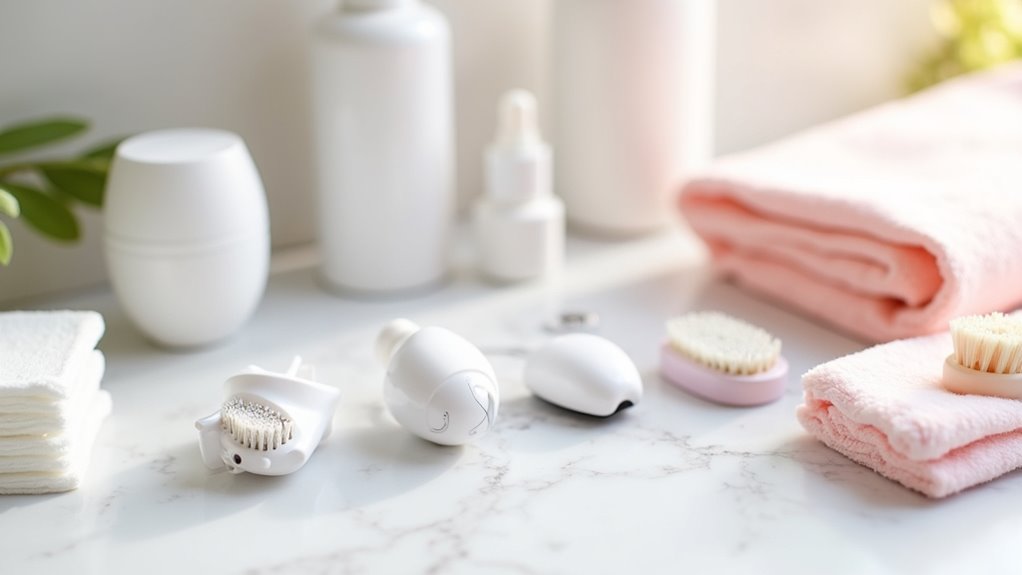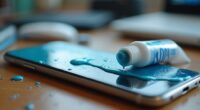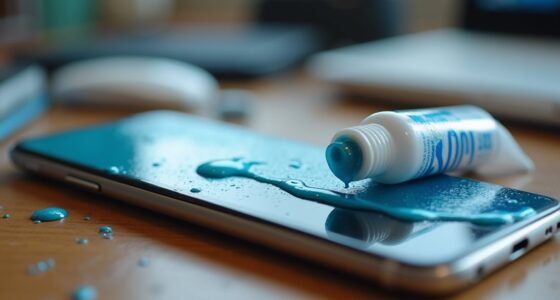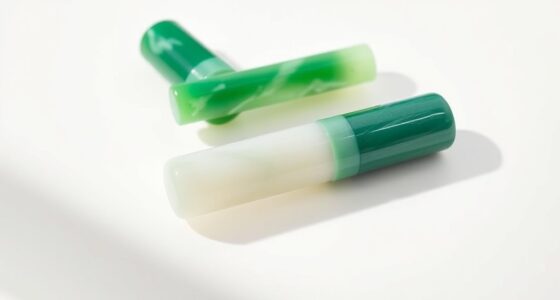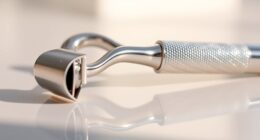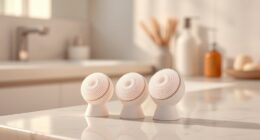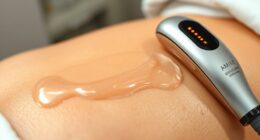Sharing beauty devices can pose health risks like bacterial, fungal, or viral infections if you don’t disinfect them properly. Some accessories made from non-porous, hypoallergenic materials are safer to share, but many require thorough cleaning after each use. Regular disinfection, proper skin preparation, and watching for signs of contamination are key to safe sharing. Want to learn how to keep your devices and skin safe? Keep exploring for essential hygiene tips.
Key Takeaways
- Sharing devices increases the risk of spreading bacteria, fungi, and viruses, potentially causing infections or skin irritations.
- Use non-porous, hypoallergenic accessories designed for multiple users and disinfect them thoroughly after each use.
- Regularly clean devices with appropriate disinfectants and inspect for signs of contamination like residue, odors, or skin issues.
- Proper skin preparation and device disinfection before use reduce cross-contamination and infection risks in group settings.
- Maintaining strict hygiene routines safeguards device effectiveness, prolongs lifespan, and protects individual skin health.
Understanding the Risks of Sharing Beauty Devices

Sharing beauty devices might seem harmless, but it can pose serious health risks. When you share devices like razors, facial tools, or hair removal gadgets, you increase the shared device risks of spreading bacteria, fungi, or viruses. Even if a device looks clean, microscopic bacteria can linger, leading to infections or skin irritations. Without a strict hygiene protocol, these risks multiply. Many people underestimate how easily germs transfer via shared tools. Proper cleaning, disinfecting, and avoiding sharing altogether are essential steps. Failing to follow hygiene protocols can result in breakouts, herpes, or other contagious conditions. Protect your health by understanding these risks and prioritizing your safety. Remember, maintaining hygiene isn’t just about appearance—it’s about safeguarding your well-being. Being aware of hygiene practices can significantly reduce the likelihood of infections.
Which Beauty Accessories Are Safe to Share?
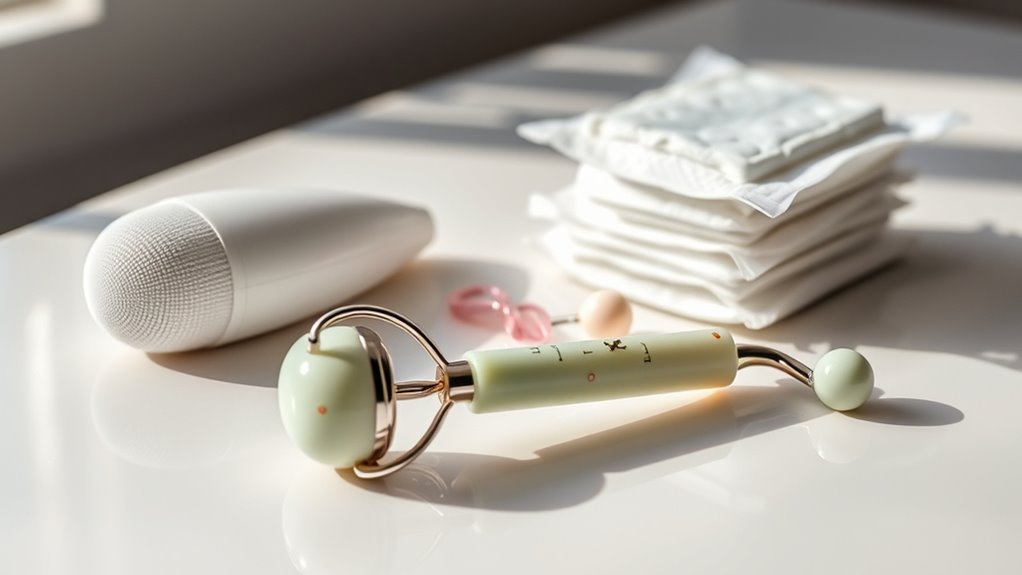
While many beauty tools carry risks when shared, some accessories are safer to pass around if proper precautions are taken. Items like facial cleansing brushes with non-porous, hypoallergenic device materials are generally safer because they’re easier to clean thoroughly. Makeup sponges or applicators made from silicone or synthetic materials are also more user-compatible, reducing the risk of bacteria transfer. Always ensure the device material is compatible with cleaning methods, and check if the accessory is designed for multiple users. Avoid sharing items that have direct contact with your skin or mucous membranes unless they’re disposable or specifically meant for sharing. By choosing accessories with safe device materials and ensuring user compatibility, you minimize potential health risks. Additionally, selecting items with appropriate hygiene features can further reduce contamination concerns.
How to Properly Disinfect and Maintain Your Devices

To keep your devices safe and hygienic, always clean them before each use. Use the right disinfectants and follow a regular maintenance schedule to prevent bacteria buildup. Proper upkeep makes sure your devices stay effective and safe for sharing. Regularly inspecting your devices for wear and tear can also help maintain their hygienic condition and ensure they remain safe for use.
Clean Before Each Use
Ensuring your beauty devices are clean before each use is essential for maintaining safety and effectiveness. Proper device sterilization is a key part of your hygiene routines, preventing bacteria buildup and reducing infection risk. Before using your device, wipe it down with a clean cloth or alcohol-based wipe to remove surface dirt. Pay special attention to nooks and crevices where debris can hide. Avoid sharing devices without thorough cleaning, as cross-contamination can occur. Regularly cleaning your devices not only protects your skin but also prolongs their lifespan. Incorporating a quick sterilization step into your daily hygiene routines helps prevent bacteria growth and keep your devices safe and ready for use. Regular cleaning is a simple yet indispensable habit for safe beauty practices.
Use Appropriate Disinfectants
Using the right disinfectants is crucial to effectively eliminate bacteria and germs without damaging your devices. Different disinfectant types, such as alcohol-based solutions, hydrogen peroxide, or specialized sterilizing wipes, are suitable for device sterilization. Always check your device manufacturer’s instructions to confirm compatibility with specific disinfectants. Proper disinfectants kill germs without corroding or degrading device components. To disinfect, apply the chosen solution thoroughly, ensuring all surfaces are covered. Avoid using harsh chemicals like bleach unless explicitly approved, as they can harm your device. Regularly disinfect your devices after each use, especially if sharing, to maintain hygiene and prevent cross-contamination. HEPA filtration can help capture airborne bacteria and allergens that might settle on your devices, reducing contamination risks. Correct disinfectant use is a simple but essential step in keeping your beauty devices safe and hygienic.
Regular Maintenance Schedule
Establishing a regular maintenance schedule is essential for keeping your beauty devices safe and effective. By consistently disinfecting and maintaining your devices, you enhance hygiene awareness and extend their device longevity. Here’s what to do:
- Clean after each use: Wipe down surfaces with appropriate disinfectants to remove residue and bacteria.
- Deep disinfect weekly: Use suitable cleaning solutions to thoroughly sanitize all components.
- Check for wear: Regularly inspect parts for damage or buildup that could compromise safety.
- Store properly: Keep devices in a clean, dry place to prevent dust and bacteria accumulation.
- Understand hygiene accessories: Using proper hygiene accessories can help maintain cleanliness and prevent cross-contamination.
Following these steps helps guarantee your devices stay hygienic, safe, and effective, promoting better skin health and prolonging their lifespan.
The Importance of Personal Hygiene Before Use
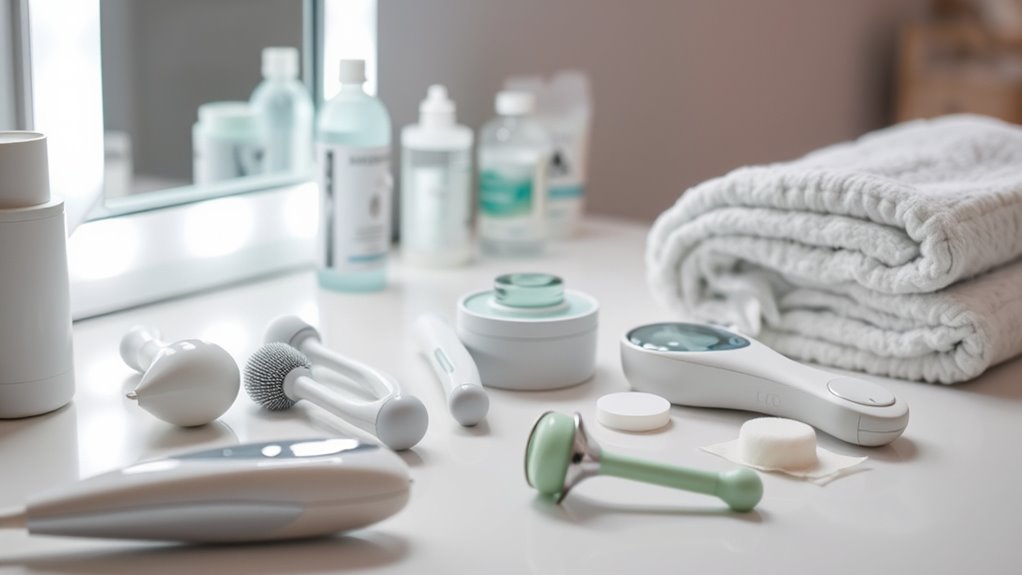
Before using a shared beauty device, make sure your hands are thoroughly washed using proper techniques to remove dirt and bacteria. It’s also important to clean your skin and prepare it with the right products to prevent infections. Keeping both your hands and skin clean helps guarantee safe and effective use of the device. Additionally, using proper hygiene solutions can further reduce the risk of cross-contamination.
Handwashing Techniques Matter
Since your skin can carry dirt and bacteria that might transfer to beauty devices, washing your hands thoroughly before use is essential. Proper handwashing techniques help maintain hygiene awareness and prevent infections. Focus on these steps:
- Wet your hands with warm water.
- Apply enough soap to cover all surfaces.
- Scrub your hands for at least 20 seconds, paying attention to nails and between fingers.
- Rinse well and dry with a clean towel or air dry.
- Remember, maintaining personal hygiene is crucial for safe beauty device use.
Clean Devices Regularly
Regularly cleaning your beauty devices is essential to prevent bacteria buildup and guarantee safe use. Proper hygiene habits not only protect your skin but also extend the device’s longevity by preventing damage caused by debris or residue. When you maintain a routine of cleaning after each use, you reduce the risk of infections and ensure your device functions at its best. Use the recommended cleaning methods for your specific device, whether it’s wiping with alcohol or washing with gentle soap. Neglecting this step can lead to dirt accumulation, which diminishes effectiveness and may cause skin irritation. Additionally, maintaining cleanliness standards is crucial for avoiding cross-contamination and ensuring consistent results. By prioritizing hygiene habits and cleaning your devices regularly, you guarantee your tools remain safe, effective, and durable for long-term use.
Skin Prep Essentials
Ensuring your skin is clean and dry before using beauty devices is essential for maximizing their effectiveness and preventing irritation. Proper skin prep also helps maintain device longevity and reinforces good hygiene habits. To prepare, you should:
- Gently cleanse your face with a mild cleanser to remove dirt, oil, and makeup.
- Pat your skin dry with a clean towel to avoid moisture that can harbor bacteria.
- Avoid applying heavy creams or oils that could interfere with device performance or hygiene.
- Consider using alcohol wipes on the device contact points to reduce bacteria transfer and support hygiene habits.
- Recognizing the importance of trust issues in maintaining consistent hygiene routines can help reinforce your commitment to proper skin care practices.
Following these steps ensures your skin is ready and your device stays hygienic, reducing the risk of infection or irritation. Prioritizing skin prep protects your skin and prolongs your device’s lifespan.
Identifying Signs of Contamination or Infection

You need to stay alert for any signs that your beauty device may be contaminated or infected. Look for contamination indicators like unusual residue, discoloration, or persistent odors. These can signal that bacteria or mold are present. Infection symptoms may include redness, swelling, or soreness after use, which suggest the device has caused irritation or infection. If you notice pus, blisters, or a rash, stop using the device immediately. Any persistent discomfort or new skin issues are warning signs of potential contamination or infection. Regularly inspecting your device for these signs helps prevent health risks. If you detect any contamination indicators or infection symptoms, clean the device thoroughly or consider replacing it to ensure safe use.
Best Practices for Multiple Users
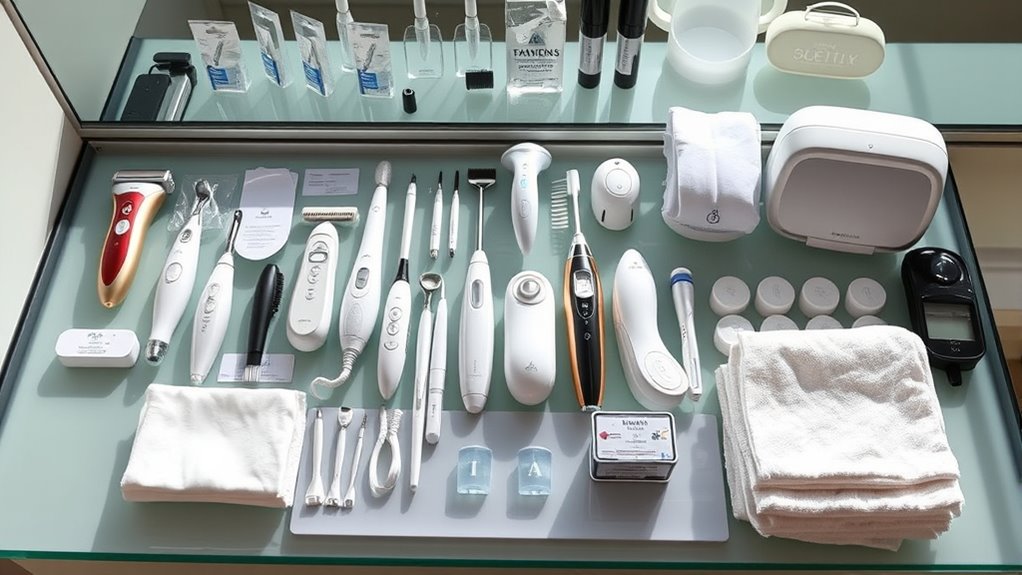
Sharing beauty devices among multiple users can increase the risk of cross-contamination if proper hygiene practices aren’t followed. To guarantee safety, follow these best practices for device sharing:
- Always disinfect devices thoroughly after each use with appropriate cleaning solutions.
- Use disposable barriers or covers on devices to prevent direct contact.
- Avoid sharing devices if anyone has skin infections or open wounds.
- Store devices in clean, dry containers between uses to reduce contamination.
Tips for Safe Sharing in Group Settings
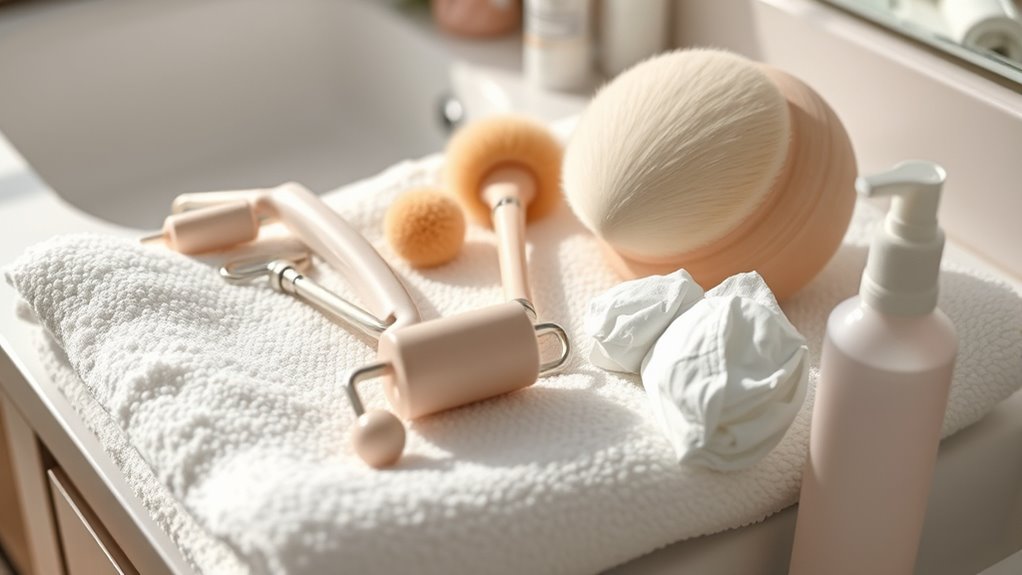
When multiple people use the same beauty device in group settings, maintaining hygiene becomes even more important to prevent the spread of germs. Follow proper sharing etiquette by disinfecting the device thoroughly between users, using alcohol wipes or appropriate cleaning solutions. Respect privacy considerations by informing users about cleaning protocols and allowing them to choose settings or accessories that ensure their comfort. Avoid sharing devices that aren’t designed for multiple users or don’t have removable parts that can be sanitized. Limit the number of users per session and encourage good personal hygiene beforehand. Communicate openly about hygiene practices to build trust. By adhering to these tips, you can help ensure safe, respectful, and hygienic sharing in group beauty routines.
Frequently Asked Questions
Can Sharing Beauty Devices Cause Skin Allergies or Irritation?
Sharing beauty devices can increase your risk of skin allergies or irritation, especially if you have sensitive skin. When you share, bacteria and other irritants can transfer, triggering skin sensitivity or allergic reactions. To prevent allergy risks, always clean your devices thoroughly and avoid sharing with others. By taking these precautions, you protect your skin’s health and reduce the chance of irritation caused by contaminated tools.
Are There Specific Materials That Are Safer for Shared Devices?
Imagine each device as a tiny fortress guarding your skin; choosing the right materials keeps it secure. When sharing beauty devices, focus on material safety—look for medical-grade or hypoallergenic options to prevent reactions. confirm device compatibility with your skin type, avoiding porous or cheap plastics that harbor bacteria. Selecting high-quality, non-porous materials minimizes risks and helps maintain hygiene, making shared use safer and more dependable.
How Long Do Disinfected Devices Remain Safe to Use?
You might wonder how long disinfected devices stay safe to use. Generally, the device lifespan depends on the material and how well you maintain it. Proper disinfectant efficacy guarantees germs are eliminated, but most disinfectants only provide temporary protection. To keep your device safe, re-disinfect it after each use and avoid prolonged exposure to moisture. Regularly check for wear and tear, as damaged devices may compromise safety over time.
Is Professional Sterilization More Effective Than Home Cleaning?
Think professional sterilization is overkill? Well, it actually extends your device’s longevity better than home cleaning. Advanced sterilization methods remove bacteria thoroughly, ensuring your device stays safe and effective longer. While home cleaning is convenient, it may miss hidden microbes, risking damage or reduced performance. So, if you’re serious about maintaining your device’s ideal condition, trusting professionals might be the smarter choice for better device longevity and thorough sterilization.
Can Sharing Devices Lead to the Spread of Viral Infections?
Sharing beauty devices can increase cross contamination risks, making bacterial transmission more likely. When you share devices, you may unknowingly transfer germs and viruses from one person to another, especially if proper hygiene isn’t maintained. To protect yourself, avoid sharing devices and thoroughly disinfect them after each use. This helps minimize bacterial transmission and reduces the chances of spreading viral infections, keeping your skin and health safer.
Conclusion
Sharing beauty devices can increase your risk of infection, especially since studies show that up to 60% of device surfaces can harbor bacteria if not properly cleaned. To stay safe, always disinfect your devices between uses, practice good personal hygiene, and avoid sharing accessories with multiple people. Remember, a little extra care goes a long way in preventing skin issues and infections. Prioritize your health and enjoy beauty routines confidently and safely.
